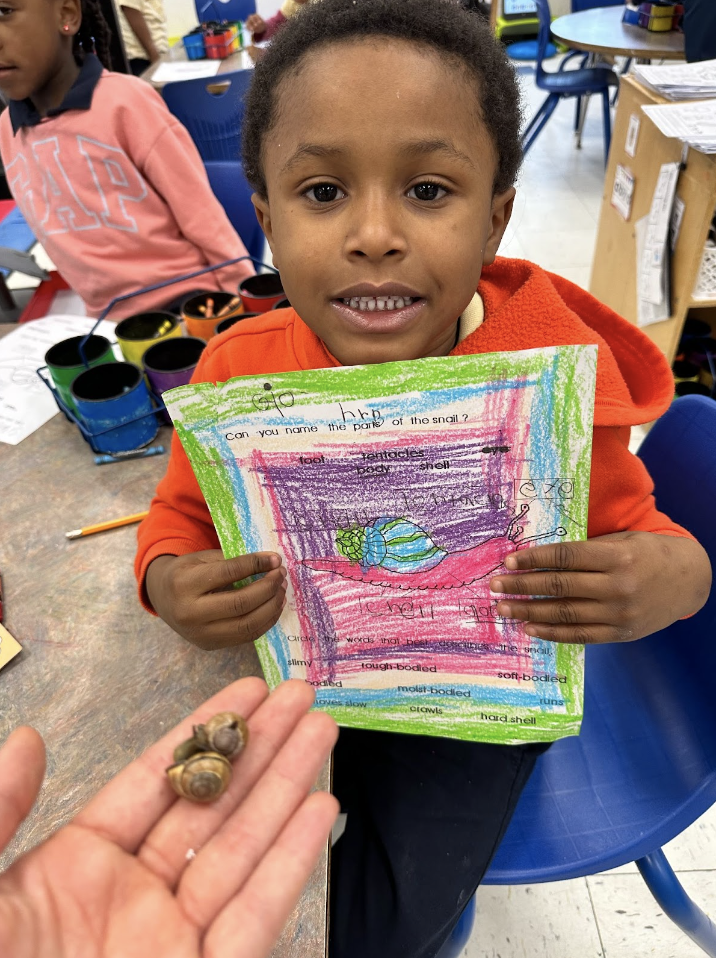"Snailed it!"
Leila Skinner, Youth Education Coordinator
feat. Jordan Finkelstein, Garden Educator
As an educator at CitySprouts, the most commonly asked question is:
“How are you going to teach in the garden during the Boston winter?”
And the answer is, we bring the garden to our students inside! In January, with lows of 20°F and snow piling up, CitySprouts Garden Educators across Boston and Cambridge are finding ways to creatively engage their students with indoor environmental science learning.
Though skies are gray and temperatures are frigid outside, at Orchard Gardens K-8 Pilot School in Lower Roxbury, classrooms are full of color and paper snowflakes that students made in Gardener Jordan’s lesson on snow. On this special Tuesday in Ms. Brown’s K2 class, Gardener Jordan is bringing a special guest into class with him - a decomposer from the garden!
Gardener Jordan starts the lesson by asking students which critters they remember seeing in their garden. The four and five year olds are quick to shoot their hands up and exclaim “birds!” “worms!” and “ladybugs!” After fielding a few excited answers, Gardener Jordan explains that there is one creature they haven’t looked at before: snails. He brings out a jar full of empty snail shells to pass around to the students to feel, shake, smell, and admire the patterns on the shells. Because snails are delicate garden creatures, starting with just shells that no longer have living things inside allows the students to use their five senses to interact safely with the creatures.
Observing the live snails
After the students examine the shells and share observations of what they see and feel, Gardener Jordan then comes around with two live snails that he’s brought in a snail terrarium equipped with an old egg carton, pinecone, water dish, and cut apples for the snails to snack on. Students carefully admire the snails’ two eyes, two tentacles used for sensing, and their soft and slimy body. “This is my absolute favorite part of the lesson,” Gardener Jordan later shares.
“Starting with the shells helps students to distinguish living and nonliving elements, and emphasizes to them that snails are fragile, so they treat them gently when I pass them around. Showing them the terrarium is also helpful - it opens some great conversations about what decomposers need to survive, and cements the students’ understanding of these little critters as living things.”
Gardener Jordan then shares a diagram of snails’ body parts that students will use to label and describe the snails. The K2 students succeed in matching the single “foot” of the snail to the bottom, and after repeating the word tentacles together, Gardener Jordan explains that the two small nubs help the snail feel it’s surroundings.
Gardener Jordan shows the students the snails' tentacles
Students then return to their desks, where they practice labeling their own snail diagram, using descriptive adjectives (ie. slimy, slow, hard shell), and creatively coloring in their snails. Some students select colors to match the snails they observed, while others opt for a more whimsical palette. Meanwhile, Gardener Jordan brings around the live snails for the students to closely examine.
Students share observations and predictions about the snails. After learning the snails retreat into their shells when they feel threatened, one student guesses, “Maybe the snails have a stove, fridge, and stuffy in their house just like we do!” Another student carefully traces the spiral shape on the shell and guesses its colors help it camouflage with the plants. Much to their surprise, the snail’s tentacles and eyes retreat into its body when Gardener Jordan gently taps them - a useful example of how these critters protect themselves in the garden!
The months of January and February will continue to include lessons on snails, worms, roly polies, and even mealworms. These small creatures often go unnoticed, but they are crucial parts of the garden ecosystem - winter is an ideal time to take a closer look at them! By bringing decomposers indoors, Garden Educators can continue conversations about decomposition and composting during indoor CitySprouts garden instruction. These K2 students in Orchard Gardens K-8 Pilot School are just one class out of the twenty-four school partners of CitySprouts learning about the living creatures in the world around us.
A student raises his hand to share an observation
Closely studying the snails
A student shows off his beautiful snail coloring





